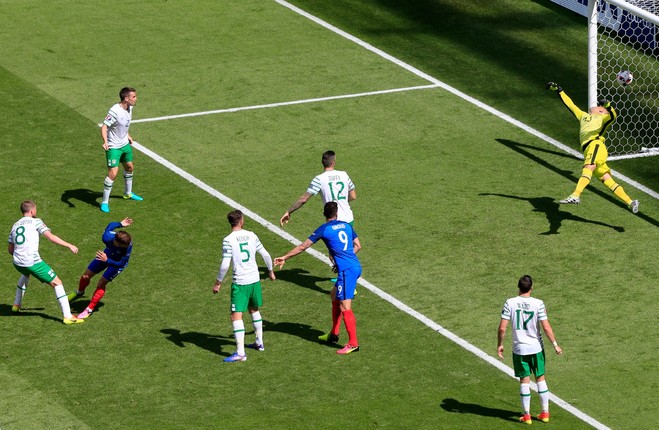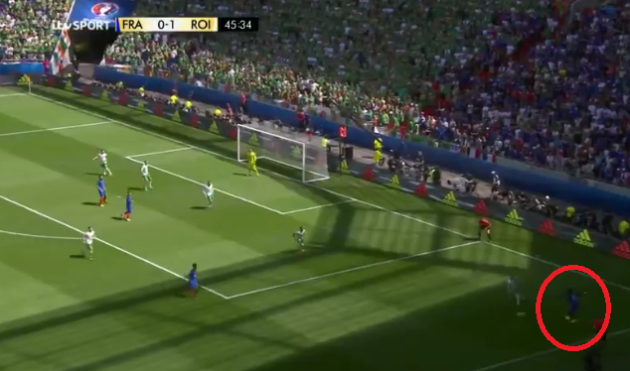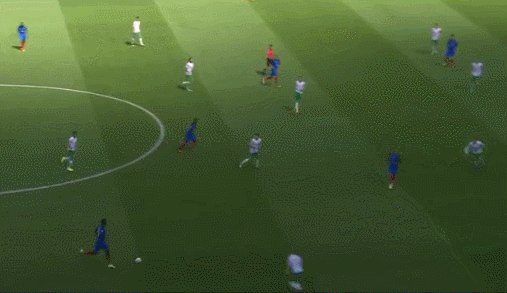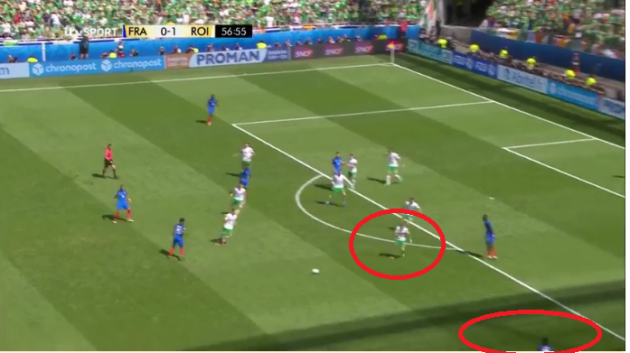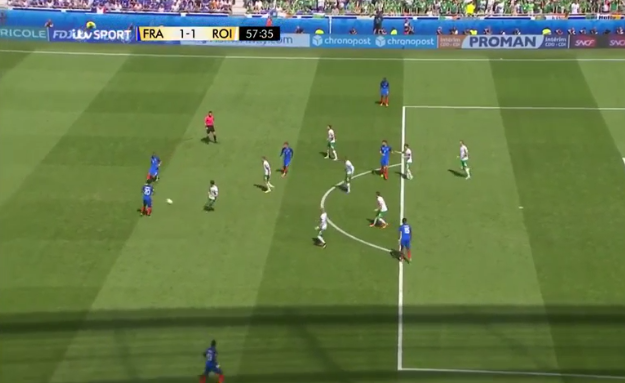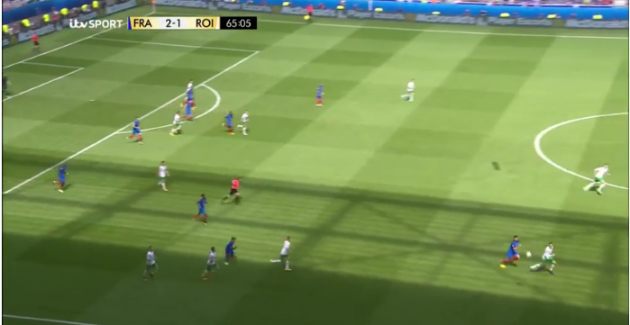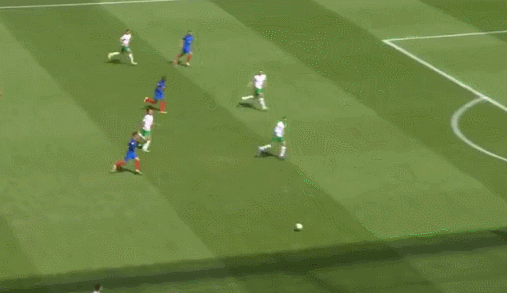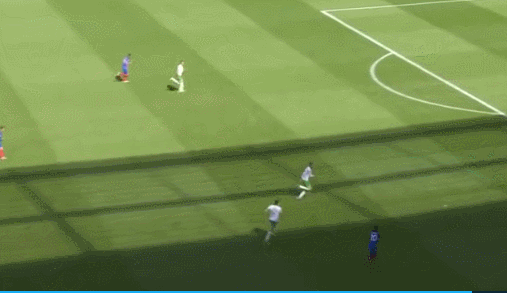Overview
PLENTY OF REASONS have been cited for Ireland’s Euro 2016 exit at the hands of France last Sunday.
Tiredness, unfavourable refereeing decisions, lack of recuperation time, inability to keep the ball, defensive errors, competing in a hostile atmosphere in Lyon and players simply not being good enough have all been cited in the aftermath of the defeat by the hosts, and all these criticisms are valid to some degree.
Yet one problem which hasn’t really been looked at in detail yet is Ireland’s problematic left flank, and indeed their problems coping with opponents’ threat down the wings in general.
Consequently, of the six goals they conceded at Euro 2016, five came down Ireland’s opponents’ right flank.
Over the course of this article, we will look at why this has become such an issue for the team, and how rivals are starting to consciously exploit this ostensible area of weakness.
Ominous signs from the past
Ireland’s problems down their left side were apparent even before they reached Euro 2016.
In an article last year, we looked in depth at how speedy Bosnian right winger Edin Višća and full-back Mensur Mujdža continually caused Robbie Brady and Stephen Ward problems down Ireland’s left-hand side in the fog-enshrouded first-leg qualifying playoff between the sides.
But fortunately for Martin O’Neill’s men, despite the Bosnians getting to the by-line and finding themselves in promising positions on a couple of occasions, the final ball invariably was not good enough.
It was telling that Ward was replaced by Marc Wilson after 67 minutes of the game in question, while James McClean was also brought on in place of Wes Hoolahan in the 60th minute in an attempt to provide Ireland with better protection on the left.
Even still, however, Bosnia’s 85th-minute equaliser emanated from their right flank, as Senad Lulić played through substitute right-back Ognjen Vranješ, who had capitalised a lapse in concentration from James McClean, and Džeko made no mistake with a simple finish from close range after the defender’s precise cross.
Ireland played a 4-2-3-1 formation in that game, with a very narrow set-up, and consequently, Ward was left exposed at times owing to this strategy.
In the return leg against Bosnia, the Irish side kept the same formation, though Brady rather than Ward was at left-back. The Irish side still encountered a few problems down Bosnia’s right-hand side, though the Boys in Green were on the front foot more often in this home encounter, and so the issue was less apparent.
Sweden changes
Perhaps with the issues against Bosnia in mind, Martin O’Neill tried a slightly different formation in Ireland’s Euro 2016 opener against Sweden, while sticking with largely the same personnel.
Ireland started the match with a diamond formation — Jon Walters and Shane Long up top, with Wes Hoolahan the most advanced midfielder, while Glenn Whelan was sitting, and James McCarthy and Jeff Hendrick were required to play in the centre, while asked to drift to the flanks and protect the full-backs if necessary.
Initially, this strategy appeared to pay off, as Ireland were the much better side in the first half. However, once the Boys in Green went ahead, they sat back too deep, and Sweden were able to expose them on the flanks, as the Irish side tired.
Interestingly, this match was the one game where Ireland’s right-side was more of a problem than the left. James McCarthy playing in a somewhat unfamiliar position, looked fatigued having only just returned from injury, and Ireland were slow to address the growing threat posed by Swedish left-back Martin Olsson. We’ve looked in detail here at how the Norwich man was regularly afforded far too much time to get deliveries into the box, as McCarthy struggled to close him down in his role as the right-sided central midfielder.
Belgian debacle
For the Belgium match, Ireland again altered their formation slightly.
With Jon Walters injured, Shane Long started up front on his own. Ward was recalled with Brady pushed into midfield,
Consequently, the diamond formation was ditched, and Ireland went with a more conventional 4-4-1-1, with Hoolahan playing in behind Long.
Unfortunately for Martin O’Neill, this approach did not pay dividends. The Irish side struggled to keep the ball and by the start of the second half, they were already exhausted from continually chasing it, as relentless Belgian pressure ultimately told.
And of course, there was a sense of deja vu from the Bosnia away match, as Ireland were continually exposed down their left-hand side.
For the first goal, a James McCarthy missed tackle proved costly, as Kevin De Bruyne rampaged down the right wing. Robbie Brady was also caught out of position and couldn’t get back in time to stop the Man City star from supplying Romelu Lukaku, who finished consummately.
13 minutes later, Axel Witsel made it 2-0 with a bullet header. It was a killer blow, and much of the blame was attributed to James McCarthy for failing to track his opposition midfielder. However, even before that, Thomas Meunier was given far too much time to deliver a pinpoint cross, as Jeff Hendrick and other Ireland players on the left side stood off the Belgian right-back.
And finally, the Belgian right flank was the source of Ireland’s problems again for the third goal. It should be pointed out that the game was stretched at this point, so it was somewhat inevitable that there was plenty of space for Belgium to expose on the counter-attack, with centre-back Ciaran Clark attracted to the left-back position in the absence of anyone else.
Clark’s desperate lunge, which failed to stop the onrushing Eden Hazard, was a poor decision in hindsight. The Aston Villa man could alternatively have tried to hold the Chelsea attacker up. But after he committed, it was a challenge he needed to make. And after this glaring error, it was perhaps no surprise that Clark, despite impressing in qualification, was dropped for Ireland’s next two matches.
France target Ireland’s area of weakness
As tempting as it is to dwell on past glories, we will skip past a lengthy analysis of the Italy game, as Ireland were on the front foot more often than not and were largely defensively sound, with the Italians registering just one shot on target in the whole match.
For the daunting last-16 clash against tournament favourites and hosts France, Martin O’Neill stuck with the exact same team and formation for the first time in the tournament.
Ireland played a 4-3-3 which turned into a 4-5-1 at times, with James McClean and Shane Long either side of central striker Daryl Murphy.
The first half was encouraging from an Irish perspective, as Robbie Brady’s penalty gave the Boys in Green a 1-0 lead.
Moreover, France, despite creating a few decent chances, looked out of sorts and frustrated.
Nevertheless, a chance just before half-time for the hosts provided a sign of what was to come, as Blaise Matuidi found space down Ireland’s left side. The PSG man’s cross fell into the path of first Payet and then Griezmann, both of whom saw their shots blocked by Stephen Ward and Shane Duffy respectively.
However, if they didn’t already know beforehand, France would have surely realised at this point that Ireland’s left-hand side was an area of weakness that could be targeted. With this in mind, coach Didier Deschamps replaced holding midfielder N’Golo Kante with a natural right winger, Bayern Munich’s 20-year-old star Kingsley Coman. As a result, Stephen Ward looked increasingly exposed and overworked in struggling to deal with this threat down the left.
So, after just 34 seconds of the second half, France were already testing Ireland’s left side (see image below).
Remember that James McClean was not being asked to play as an out-and-out winger. Instead, the West Brom man was part of a three-man attack, with himself and left central midfielder Brady both partially responsible for covering France’s right-sided threat.
Sagna key to French rejuvenation
In the end, it was arguably France right-back Bacary Sagna, rather than Coman or Groezmann, who was the key player in getting his team back in the game.
The French side continually probed down the right, though Sagna’s deliveries were inept initially.
Just as Ireland afforded too much space to full-backs Martin Olsson and Thomas Meunier in the Sweden and Belgium matches respectively, again there was a sense of deja vu, as Sagna had plenty of time and space to pick out crosses on numerous occasions.
France’s equaliser came directly as a result of Ireland’s failure to close down the Man City defender.
Throughout the tournament, Ireland’s narrow set-up had been problematic from a defensive perspective, and it was blatantly an issue for Antoine Griezmann’s first goal.
The Boys in Green were too focused on France threading the ball through the centre, and as a result, no one picked up Sagna out wide.
James McClean belatedly ran out to try to stop the cross, but it was too late, as the full-back delivered the perfect ball onto the head of Atletico Madrid star Griezmann.
France were well on top at this stage, with 76% possession. Having had an extra three days’ rest from their last group game, they were also clearly the fitter of the two sides.
Mistakes began to creep into Ireland’s game more consistently after the concession of the first goal, and with a renewed sense of momentum, the French struck again three minutes later.
The second goal was more a communication issue in central defence than a problem out wide, with both Duffy and Keogh trying and failing to beat Olivier Giroud to a header, before Griezmann subsequently scored his second from the Arsenal man’s knockdown.
Furthermore, as with the latter stages of the Belgium game, this match was now becoming extremely open, as Ireland pushed forward in desperate search for an equaliser.
Just as Clark had found himself at full-back against Belgium for the third goal, Keogh was in the left-back position during one Belgium attack. The Derby man failed to deal with the bouncing ball, as he was shrugged off possesion by Giroud, whose pass sent Griezmann through, forcing Shane Duffy to commit the foul that led to his sending off and effectively ended the game as a contest.
Even after France’s second goal, they continued to focus the majority of their attacks down the right-hand side.
Coman and Sagna saw plenty of the ball, but the end product was invariably substandard, as Decshamps’ men failed to put a degree of gloss on the scoreline.
It mattered little, however, as the damage had already been done.
Conclusion/summary
While the odd goal or two could be written off as a coincidence, the fact that five of Ireland’s six goals conceded at Euro 2016 came down the left flank indicates that this is a significant area of concern for the Boys in Green.
It’s not a problem that can be blamed on one or two individuals. As mentioned above, there have been plenty of changes in personnel over the course of the campaign, yet the issue remains.
Perhaps it is more to do with how Martin O’Neill’s sides are set up (although fatigue and the players being unable to handle the workload required to get across and stop crosses going into the box was also undoubtedly a factor). In every game at the Euros, Ireland played with a narrow formation. Even with James McClean in the side, the West Brom winger operated more centrally than he usually does with his club.
Ireland often played well when on the front foot with their various formations — Italy and the first half against Sweden being prime examples. However, too often, when they were forced to defend, they looked vulnerable on the left flank.
Whether a solution to the problem can be found remains to be seen, but it is likely an issue Martin O’Neill will be keen to address ahead of Ireland’s first 2018 World Cup qualifier against Serbia on 5 September.
The42 is on Snapchat! Tap the button below on your phone to add!
